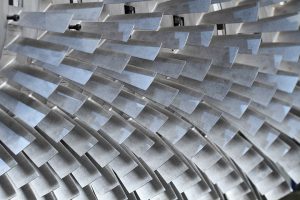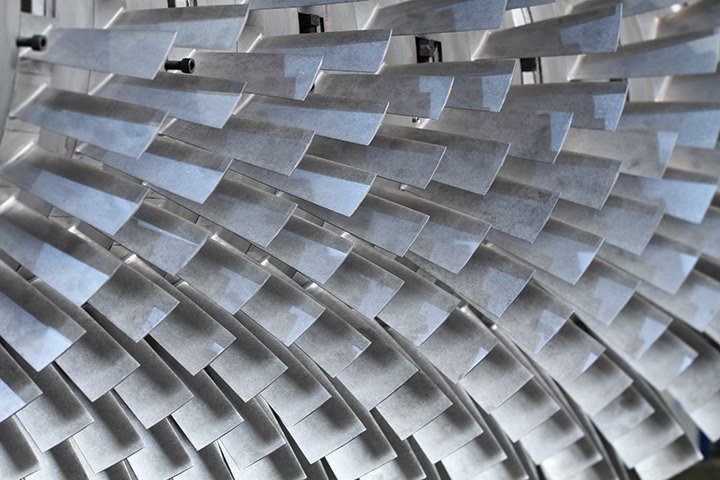

Photo Credit: Getty Images.
The objective of gas turbine maintenance is to maximize performance, improve maintainability and reliability, and reduce downtime.
The objective can only be achieved by preventing turbine systems deterioration with an effective condition monitoring and maintenance program.
This program must pay particular attention to five turbine operational conditions:
• The thermodynamic gas path;
• Turbine vibration and instability;
• Lubricant and lubrication system condition;
• Parameters for online condition monitoring; and
• Scheduled inspection and proactive maintenance activities.
These operational considerations affect one another, and the components related to each system must be in excellent condition to ensure optimum performance of the turbine.
1. How do you manage the thermodynamic gas path conditions?
Logic: The gas path includes the condition and cleanliness of the compression intake air, fuel quality, and the integrity and quality of the combustion process and turbine exhaust.
Contaminants that contribute to turbine erosion, corrosion, fouling, and sulphidation that attack turbine blade and nozzle materials require high-efficiency air filtration. A decrease in turbine power output or compressor efficiency, or an increase in the frequency of cleaning the compressor is that the filter system is not functioning satisfactorily. There are many fuel types used in gas turbines, from distillate and residual oils to various fuel gases, such as propane, natural gas, methane, or gas produced from biomass processes.
Operators must be aware of fuel and governor control problems often associated with “hot” or “hung” starts caused by a too-rich fuel or too-lean fuel schedule, respectively. Pollutants such as hydrocarbons, carbon monoxide, sulphur oxides, and nitrogen oxides are all products of the turbine combustion process. These pollutants can be reduced or eliminated by using properly designed combustors, reducing combustion temperature with water or steam injection into the combustion process, or by using a selective catalytic converter in the turbine exhaust. In addition, turbine exhaust temperature is a critical condition that should be monitored continually.
2 . What turbine vibration and instability conditions should you consider critical?
Logic: Vibration of rotors, bearings, and gear box components can directly affect efficiency and reliability, and online vibration analysis should be a requirement. Depending on design, proximity transducers to measure displacement can be located at radial bearings, while accelerometers should be considered to measure frequencies of compressor and turbine blades. Handheld vibration monitoring devices should also be used when or if a specific problem is suspected.
Bearing problems in gas turbines are related to lubricant quality, contaminants, wear, temperature, and vibration. Gas turbines run at high speed; aero-derivatives run at speeds that range from 9,000 to 20,000 RPM, while heavy industrials operate at speeds in the 3,000 to 12,000 RPM range. Some industrial turbines use hydrodynamic journal bearings, but all of the new aero-derivatives and most industrials now use rolling element bearings to support the rotors and shafts.
3. What lubricant and lubrication system conditions are important in your application?
Logic: Considerations include the condition of the lubricant and the reliable operation of the lubrication system. The lubrication system must be periodically inspected for oil leaks at connections, piping, seals, and fittings. Oil levels should be monitored on a daily basis, and oil pressure and temperature must be part of the condition-monitoring program.
Foaming or frothy oil is caused by hot air or gas leaking into the lubrication system past labyrinth or mechanical seals. Oil pressure is indicative of the pressure drop across filters and can indicate internal leaks if external leaks are not present but the oil level is dropping.
Internal leaks are difficult to detect and can result in oil leaking into the hot gas path. This may or may not be indicated by either a gradual or a sudden appearance of exhaust smoke. If internal leaks are suspected, inspection of the combustor, exhaust duct, compressor discharge, or air bleed discharge may be possible using a borescope to look for traces of oxidized oil or varnish in these components. Monitoring oil temperature can be carried out by measuring temperature of oil leaving the bearings, the actual oil temperature at the return line to the reservoir, or measuring the bearing temperature using contact thermocouples or resistance temperature detectors.
An increase in oil temperature can occur quickly if leaking seals allow hot gases to leak into the oil. Oil temperature will also increase if the cooler is inefficient or plugged, or if the cooler doesn’t have the correct capacity for the system.
4. Depending on your turbine operation, which of the following parameters for condition monitoring are critical?
Logic: Depending on design, gas turbines may include some or all of the following requirements.
a) Ambient air temperature and barometric pressure;
b) Inlet air pressure at the compressor;
c) Low-pressure compressor “out” pressure;
d) High-pressure compressor “out” pressure;
e) RPM, single shaft;
f) RPM, dual shaft;
g) RPM, free power turbine;
h) Fuel flow and pressure;
i) Exhaust total pressure and exhaust gas temperature;
j) Overall vibration levels;
k) Lubricant oxidation inhibitors, acid number, and contaminant
levels; and
l) Oil pressure and temperature.
5. Which scheduled inspections and proactive maintenance activities are required at your facility?
Logic: These should include, but may not be limited to, annual fuel nozzle inspection and/or replacement, governor control system inspection and testing, water or chemical washing procedures, and borescope inspections. When used in conjunction with gas path, vibration, lubricant, and turbine condition trending analysis, borescope inspections usually provide the final step in the identification of an internal turbine problem. Borescope inspection access depends on turbine design and can provide possible evidence of damaged turbine, compressor, or combustor components, contamination buildup, fouling, erosion, corrosion, sulphidation, lubricant oxidation causing sludge and varnish, water emulsions, worn bearings and seals, plugged or damaged fuel or turbine nozzles, or broken blades or vanes.

